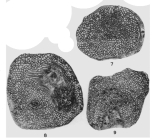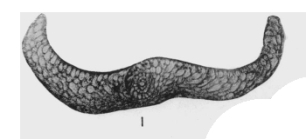
| Intro | | About | | Wiki | | Search traits | | Data explorer | | Literature | | Definitions | | Sources | | Webservices | | Statistics | | Feedback | | Editors | | Log in |
Foraminifera taxon detailsParadoxiella Skinner & Wilde, 1955 †
721781 (urn:lsid:marinespecies.org:taxname:721781)
accepted
Genus
Paradoxiella pratti Skinner & Wilde, 1955 † (type by original designation)
marine,
fossil only
feminine
Skinner, J. W.; Wilde, G. L. (1955). New fusulinids from the Permian of West Texas. <em>Journal of Paleontology.</em> 29: 927-940.
page(s): p. 934 [details] Available for editors
Hayward, B.W.; Le Coze, F.; Vachard, D.; Gross, O. (2024). World Foraminifera Database. Paradoxiella Skinner & Wilde, 1955 †. Accessed at: https://marinespecies.org/foraminifera/aphia.php?p=taxdetails&id=721781 on 2024-09-07
Date action by
original description
Skinner, J. W.; Wilde, G. L. (1955). New fusulinids from the Permian of West Texas. <em>Journal of Paleontology.</em> 29: 927-940.
page(s): p. 934 [details] Available for editors basis of record Loeblich, A. R.; Tappan, H. (1987). Foraminiferal Genera and their Classification. Van Nostrand Reinhold Company, New York. 970pp., available online at https://books.google.pt/books?id=n_BqCQAAQBAJ [details] Available for editors From editor or global species database
Diagnosis Test small, maximum diameter about 2.5 mm, adult test discoidal, thickest at the center of the disk and thinning at the periphery that may be recurved and turned upward, earliest one to one and a half whorls with short axis of coiling, then, after a 90¡ change in the direction of coiling, followed by about two whorls with elongate axis of coiling, finally flaring and uncoiling with chambers extending laterally and recurved at the ends to reach the early coil, lateral extremities of chambers finally meeting so that chambers are annular as viewed from the undulating dorsal side, septa gradually completely overlapping the test on the opposite side, septa intensely fluted, and cuniculi well developed; wall and septa very thin, with tectum and diaphanotheca, very narrow tunnel may be bordered by low chomata in the coiled part of the test, the tunnel rising from the floor in the flaring part and continuing as a series of openings near the upper edge of the septa; septal pores numerous. U. Permian (Murgabian); USA: Texas; Japan. (Loeblich & Tappan, 1987, Foraminiferal Genera and Their Classification) [details]
|



